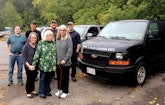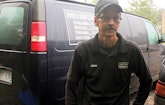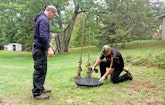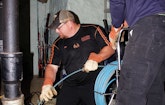
Jon Beske preps the RIDGID K-7500 drain cable machine for use on a clogged drainline at a residence that was experiencing frequent backups.
Interested in Cleaning?
Get Cleaning articles, news and videos right in your inbox! Sign up now.
Cleaning + Get AlertsMany drain cleaners strive to become full-service outfits that can satisfy customers’ every demand. Not Brian Smith.
Instead, the owner of X Rooter Sewer & Drain Cleaning in Rhinelander, Wisconsin, prefers a more narrow focus: unclogging and inspecting drainlines.
“You can simplify your life by doing one thing and doing it really good,” explains the 55-year-old contractor, who established his company in 1996 and has accrued more than 30 years of plumbing, mechanical and drain cleaning experience. “I attribute a lot of my success to focusing on one type of work.
“I did buy a septic pumper truck years ago and cleaned septic tanks for a year,” he continues. “But I knew it was a mistake after several months. … It took me away from my business objective of simplifying and specializing in doing one thing really well. Diversifying can hurt your customer service. By trying to do everything, it gets harder to control everything, from more technicians to more equipment to just more general problems and inefficiencies. I just find it easier to do one thing well and efficiently.”
Another key to Smith’s success is his knack for customizing equipment and developing creative workarounds for problems such as broken drain machine cables, which might derail other drain cleaners for hours. The customized equipment and innovative approach to problem-solving increase efficiency and productivity, which in turn boosts profit margins.
“We average about an hour per job,” he says. “We’re not there to upsell other services; we just bring the right equipment and get the job done.”
The approach seems to be working just fine. Smith says his revenue has increased by 450 percent since he started the business, with about 8 percent annual sales growth. In addition, the company now employs seven people, up from one when he first struck out on his own. He says the company is the drain cleaning leader in the market it serves, a roughly 50-mile radius around Rhinelander in north-central Wisconsin. “About 70 percent of our business comes from word-of-mouth referrals,” Smith says. “We also often get hired as subcontractors to do drain cleaning work for local plumbers.”
Specialized service
After setting up a plumbing supply store for W.S. Patterson Co. (now owned by First Supply) and then working for a mechanical-contracting firm in northern Wisconsin, Smith switched gears and worked for a local plumbing and drain cleaning company. He switched careers again around 1993 and worked for a county landfill, maintaining leachate and gas-control systems that he’d installed during his stint with the mechanical-contracting company.
In 1996, he decided to start his own company. He initially called it Expert Rooter, then shortened it to X Rooter because people seemed to have a hard time remembering the name. “I basically got tired of being mired down with too many tasks and not being able to focus on one thing and do it well,” he explains. “I did a lot of research and decided to focus on drain cleaning.
“A lot of guys go into what I call the ‘glory trades,’ like heating and air conditioning. But I wanted to get into a field with less competition, where I could specialize and do a better job than anyone else — be super efficient and provide great customer service.”
Over the years, Smith developed a preference for RIDGID equipment, which he says is durable and aids his goal of efficiency and productivity. The company owns three K-7500 drum machines; three smaller K-3800 drum machines, one K-60 midsize sectional machine, one K-40 sink and shower drain machine, and numerous RIDGID power tools.
To inspect drainlines, Smith relies on one Vivax-Metrotech pipeline inspection camera and a Gen-Eye unit made by General Pipe Cleaners/General Wire Spring. He also plans to invest in an Insight Vision Cameras inspection camera system to perform sewer lateral inspections, primarily related to pending real-estate transactions. He also owns a BuzzBox pipe locator made by Prototek.
In addition, the company owns two Water Cannon Inc. - MWBE hot-water pressure washers that Smith converted into higher-power water jetters, basically by adding a bigger hose to each; he also retrofitted one unit with a more powerful pump (10 gpm and 4,000 psi) made by General Pump (owned by Interpump Group). That latter unit is skid-mounted inside a Chevrolet 3500 cube van with a 300-gallon water tank; the 13-foot box body was made by Morgan. The other is a cart-mounted model (4 gpm at 4,000 psi).
The company runs three other service trucks: a 2003 Chevrolet 1500 Express van, a 2011 Chevrolet 1500 Express van, and a 2001 Chevrolet Suburban 2500.
Innovative approaches
An ability to think outside the box and develop new approaches to drain cleaning has also been instrumental to Smith’s success in improving efficiency and profitability. “I’m always looking for ways to do things better,” he says. “I’m always taking things apart; I’m just hard-wired that way. To solve problems, you have to stop and look at things from a mechanical sense and figure them out.”
For example, he developed a tool of sorts for retrieving snapped cables, which saves him time and his customers money by avoiding, say, breaking up a basement floor to retrieve a cable and cutting head. In essence, Smith heats up the end of a small section of 3/4-inch-diameter cable and bends it into a hook. Then he attaches it to the end of a cable with a small offset coupling and sends it down the line in reverse, so the cable is spinning counterclockwise.
The hook eventually meets the broken cable and starts twisting around it, tightening its grip the more it twists, Smith explains. “After it grabs it and winds around 10 or 20 times, I put the drive head in neutral and it’ll start to pull at the same time. It’ll pull the broken cable out and release the cutter from any obstructions through (counterclockwise) rotary action.
“You can try to use a retriever, but it will only grab if it goes in clockwise,” he continues. “And if the cutter went in going clockwise, a retriever can only get it out by going counterclockwise, but they don’t make one that does that. In this business, you run into some strange situations and sometimes you have to figure things out rather than bust up a factory or basement floor. … Necessity sometimes really is the mother of invention.”
In other instances, Smith buys cutting heads that aren’t designed to work with his RIDGID K-7500s and modifies them so they can clean 4-inch lateral lines more effectively and with less risk of breaking the pipes.
“A lot of guys in the industry won’t use a 4-inch-diameter cutter in a 4-inch pipe because it can be difficult. … They can get stuck or turn sideways and then the cable gets out of control because of the high torque,” he says. “So they use 3-inch cutters instead, which don’t clean the pipes as well.
“But by adapting 4-inch cutters to go on a 3/4-inch-diameter cable on our K-7500s, we can use a 4-inch circular-saw cutter in a 4-inch pipe without damaging the pipe. Sometimes we still can’t get a 4-inch cutter down a 4-inch line because the opening is too small or it first has to go through a 3-inch pipe. In those situations, we put in a smaller cutter with an offset on it so it spins elliptically and hits pipe walls all the way down. I make the offsets myself.” That technique works well in drainlines with a lot of offset joints; it doesn’t catch on every offset joint and still cleans the entire pipe, he says.
Controlled growth
Smith foresees more growth potential for his business and would like to add two more employees and another service vehicle by next spring. But he prefers slower and steadier growth to dramatic jumps in business, in order to maintain a high level of customer service. “My goal is around 5 percent revenue growth a year,” he explains. “I don’t like real fast growth because it makes it too hard to properly train people. Then that leads to customer dissatisfaction because technicians aren’t well-trained.
“I always tell my guys I’d rather they do a job right than do it fast,” he adds. “Callbacks are bad for our bottom line and make customers unhappy.”
Smith also doesn’t see any need to expand farther geographically in order to grow, which would help keep fuel and other travel-related costs in check. “There are more and more people moving up here from southern Wisconsin and northern Illinois,” he says. “They’re turning summer cottages into year-round residences. So some resorts are starting to run year-round, too. That all contributes to more business.
“Plus a lot of the plumbers and septic guys around here are so busy they don’t have time to do drain cleaning anymore,” he adds. “They’re starting to specialize in installations and repairs, which also makes their lives easier (than continually dealing with emergency drain clogs). Overall, I don’t see things slowing down for at least another 15 to 20 years.”
Attention on retention: Investing in employees
Brian Smith considers himself lucky because he has two solid drain cleaning technicians in the fold at X Rooter Sewer & Drain Cleaning, the company he owns in Rhinelander, Wisconsin. Jon Beske has been with the company for about 10 years, and Jake Paquette has nearly two years under his belt.
Smith’s secret to keeping good employees is simple: Higher pay, two cost-of-living pay increases a year and solid training that helps technicians maximize their pay. Smith starts employees at $12 an hour, then bumps that up to $15 an hour after a three-month probationary period. Then employees get cost-of-living raises in fall and spring to keep up with any inflation that occurs.
“And as they progress and get more experience and more efficient, I also give them interim raises of $1 or $2 an hour,” he says. “The only way to keep employees nowadays is to make sure you pay them enough to stay.
“The main problem is that drain cleaning is not a glory job,” he notes. “It’s hard work that’s pretty low on most people’s job lists. I had one employee that called himself a professional turd herder.” Then there’s the olfactory issue; some people just don’t have the stomach for the odors that come with the territory. “A lot of guys don’t even make it for three months,” he says. “There’s no hard feelings if they leave.”
But for those who stay and are motivated by money, Smith has another tool in his tool belt: comprehensive drain cleaning training. The way he looks at it, well-trained technicians can knock out jobs faster, which can have a significant impact on their pay when they work overtime.
“If they work overtime work on weekends, I give my guys a bonus of $15 per job, on top of time-and-a-half pay,” he says. “So if they can knock out an average job in an hour, they can make $45 to $60 an hour on weekends. In fact, a lot of times they’re in and out in 25 to 30 minutes on easier jobs. We bring the right equipment and get the job done, with no time wasted trying to upsell customers on other services.”
Smith says it takes a minimum of a year for technicians to learn how to properly and efficiently operate a RIDGID K-7500 drain cleaning machine, plus another two years to learn what he calls “the finer details.” Rookies also must work with a qualified technician for a year before they’re allowed to operate one on their own.
Doesn’t that hurt short-term efficiency? Yes, he concedes. But it’s a price he’s willing to pay to get better productivity in the long run, which also translates into better customer service and satisfaction. “I had to retrain myself from square one to develop my own tools and techniques to be faster and more efficient,” he explains, noting how comprehensive training pays off. “I’d say I spent three to five years and ruined a lot of cables and cutters trying to figure out ways to do things different — work better and more efficiently.”










